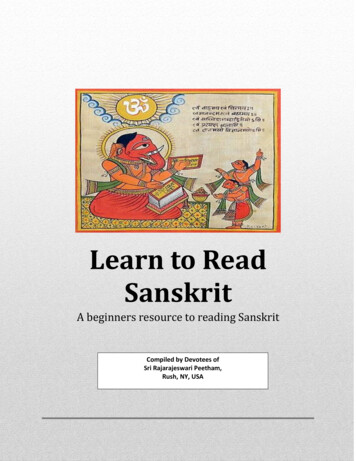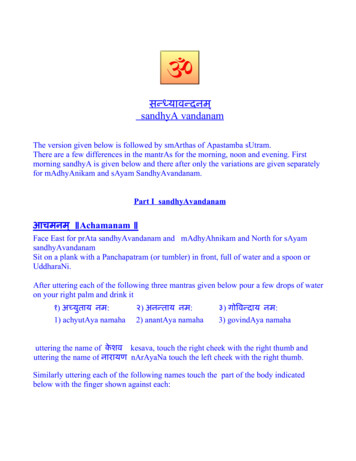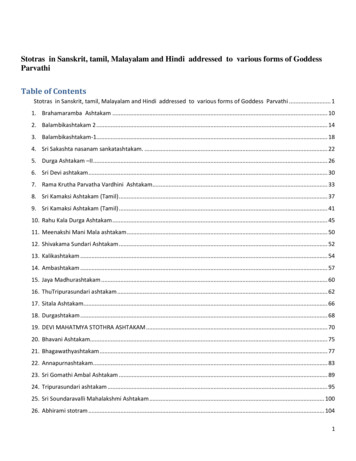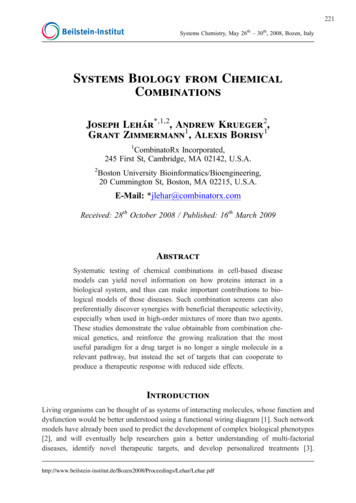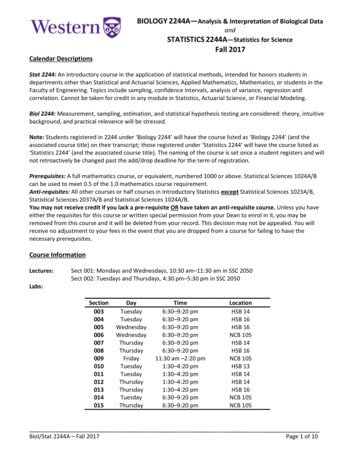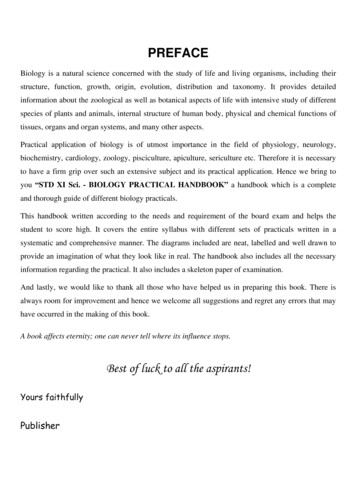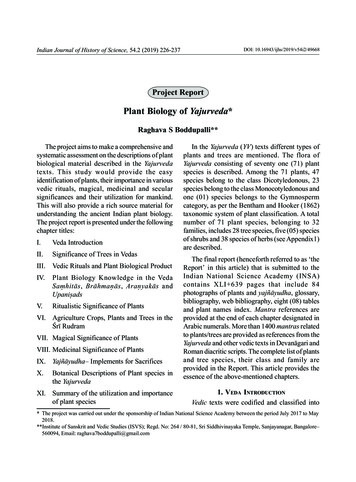
Transcription
Indian Journal of History of Science, 54.2 (2019) 226-237DOI: 10.16943/ijhs/2019/v54i2/49668Project ReportPlant Biology of Yajurveda*Raghava S Boddupalli**The project aims to make a comprehensive andsystematic assessment on the descriptions of plantbiological material described in the Yajurvedatexts. This study would provide the easyidentification of plants, their importance in variousvedic rituals, magical, medicinal and secularsignificances and their utilization for mankind.This will also provide a rich source material forunderstanding the ancient Indian plant biology.The project report is presented under the followingchapter titles:I.Veda IntroductionII.Significance of Trees in VedasIII.Vedic Rituals and Plant Biological ProductIV.Plant Biology Knowledge in the VedaSa hitās, Brāhma ās, Ara yakās andUpani adsV.Ritualistic Significance of PlantsVI. Agriculture Crops, Plants and Trees in theŚrī RudramVII. Magical Significance of PlantsVIII. Medicinal Significance of PlantsIX. Yajñāyudha– Implements for SacrificesX.Botanical Descriptions of Plant species inthe YajurvedaXI. Summary of the utilization and importanceof plant speciesIn the Yajurveda (YV) texts different types ofplants and trees are mentioned. The flora ofYajurveda consisting of seventy one (71) plantspecies is described. Among the 71 plants, 47species belong to the class Dicotyledonous, 23species belong to the class Monocotyledonous andone (01) species belongs to the Gymnospermcategory, as per the Bentham and Hooker (1862)taxonomic system of plant classification. A totalnumber of 71 plant species, belonging to 32families, includes 28 tree species, five (05) speciesof shrubs and 38 species of herbs (see Appendix1)are described.The final report (henceforth referred to as ‘theReport’ in this article) that is submitted to theIndian National Science Academy (INSA)contains XLI 639 pages that include 84photographs of plants and yajñāyudha, glossary,bibliography, web bibliography, eight (08) tablesand plant names index. Mantra references areprovided at the end of each chapter designated inArabic numerals. More than 1400 mantras relatedto plants/trees are provided as references from theYajurveda and other vedic texts in Devanāgari andRoman diacritic scripts. The complete list of plantsand tree species, their class and family areprovided in the Report. This article provides theessence of the above-mentioned chapters.1. VEDA INTRODUCTIONVedic texts were codified and classified into* The project was carried out under the sponsorship of Indian National Science Academy between the period July 2017 to May2018.**Institute of Sanskrit and Vedic Studies (ISVS); Regd. No: 264 / 80-81, Sri Siddhivinayaka Temple, Sanjayanagar, Bangalore–560094, Email: raghava7boddupalli@gmail.com
227PROJECT REPORT: PLANT BIOLOGY OF YAJURVEDAwriting by the great sage, Veda Vyasa, as thefollowing: (1) gveda—wisdom of the verses, (2)Yajurveda—wisdom of sacrificial formula, (3)Sāmaveda—wisdom of the chants and (4)Atharvaveda—wisdom of Atharvan is.The Yajurveda (a tatpuru a compound ofyajus– ‘sacrificial formula’ and veda–‘knowledge’, i.e. ‘the knowledge of sacrifice’) isthe next of the four canonical texts of the vedas. Itcontains the knowledge of principles and methodsof performing yajñas and yagas as spiritual andscientific approaches for global welfare (Sastry,1940, 1989). Yajurveda is quite different from theRV and other sa hitās. It is principally in proseform. The word ‘yajus’ in the Yajurveda isexplained as, ‘gadyatmakam yajuś’. In anotherdefinition, ‘yajur yajateś’, it talks about therelation with the sacrifice (yajña), because boththe terms are derived from the root ‘yaja’ (Sastry,1940; Raghunathachari, 1982). The YV is morepronouncedly a ritual Veda, for it is essentially aguide-book for the Adhvaryu (priest), whoperforms the yajñas and yagas (Sarma, 1989). TheYV is divided into two forms, the ‘Śukla YV’ (‘pure’or white, because the Brāhma a portions are notmixed up with the mantra portion) and the ‘K aYV’ (‘dark’ or black, in the sense of mantra beingmixed up with the Brāhma a sections). Aschematic representation on the classification ofYajurveda is provided in the Fig. 1.2. SIGNIFICANCEOFTREESINVEDASV k am (tree) is the symbol of life and growth.It stands for eternity and selfless well-being. Inthe four vedas, many herbs, vines, shrubs and treespecies are described. Our is in the Vedas haveoffered hundred-fold respects and prostrations tothe trees. is say that it is not possible to imaginelife without trees. Vājasaneya Sa hitā (VS), showimmense respect towards the trees and say oneshould have reverence and devotion towards alleatables, grains, medicinal herbs, trees, forests andvegetation. Trees are considered as devatās(deities) meaning one who keeps givingincessantly. Trees have always been beneficial tous and they possess the divine qualities that qualifythem to be addressed as devatās. Trees in Indianmythology and folklore are widely considered asFig. 1. Classification of Yajurveda.
228INDIAN JOURNAL OF HISTORY OF SCIENCEsacred and worshipped across the country for theirbenevolence. Indians believed that certain treesare the abode of gods and goddesses. The worshipof trees in India can be traced to the Indus ValleyCivilization, as clearly indicated in the IndusValley seals. The hymns of the vedas also containreferences to such sacred trees and plants onaccount of their being associated with certaindeities and also because of their potent medicinalproperties (Dymock et al., 1893). Sthala v k ās(derived from Sanskrit, i.e. sthala – place; v k a– tree) or sacred trees are found all over in India.Hence, killing trees or cutting a live tree is doinga crime against devatās.3. VEDIC RITUALS AND PLANTBIOLOGICAL PRODUCTSThrough the centuries, rituals have been asocio-cultural force in India. It is also pointed outthat it is due to these rituals the tradition has beenprotected. The fact that the vedic sacrifices havecontinued to be celebrated not only centuries afterthe vedic period but even up to the present day isan unquestionable proof of the persistence of theold religion, bearing in mind that the ‘yajña’constitutes it’s more important element (Aguilar,1976). The execution of rituals maintains thebalance of the five major elements (sky, wind, fire,water and earth) affording sun-shine and rain inreasonable measures, resulting in proper growthof crops and plenty of food. Rituals are performedto get relief from excess or scarcity of rain,diseases like small-pox and tuberculosis, dangersfrom poisonous creatures, wild animals andthieves and other sorts of disturbances (Sarma,1989).The full-moon and new-moon (darśapūr amāsa rituals) sacrifices are of great importancefor the study of the vedic ritual because they formthe model of all sacrifices called ‘i is’. The ritualsare generally classified into three viz., obligatory(nitya) such as agnihotra; incidental (naimittika)such as jāte i and optional (kāmya) such ascitrāyaga. A more detailed classification of thegroup of seven pākayajñas, haviryajñas andsomayajñas are provided in the Śrauta Sūtrās(Kashikar and Dandekar, 1958).The main object of the ritual/sacrifice is to yieldthe required desire of the sacrificer. The plants andtheir products have got a wide range of use invarious forms. A close and critical study of theplants and their products used in rituals revealsthat they have got a four-fold significance and asfar as the YV is concerned, they marks a distinctstage in the evolution of human thought.4. PLANT BIOLOGY KNOWLEDGE IN THE VEDASAM. HITA–S, BRA–HMAN. A–S, ARAN. YAKA–S ANDUPANIS. ADSProper identification of higher plants is basedupon the external structure of plant organs. Theclassification (Taxonomy) of various plant parts,their structures and growth is explained in detailin the Taittirīya Sa hitā (TS), Vājasaneya Sa hitā(VS) and related Brāhma ās. Plants are in the firstplace and are broadly classified into threegroups— (i) v k a (trees), (ii) au adhi (herbs orsmall plants) and (iii) vīrūdh (creepers or herbswith spreading stems). Various types of root andleaf forms have been described in the vedic textswhich correspond to the modern botanical terms.The Taittirīya Sa hitā classifies the plant kingdominto several classes based on its form and growth.Hence, the is, the ancient scientists, realized theimportance of classifying the plants according totheir vegetative and reproductive properties,similar to that of modern classifications of theplant kingdom. ‘Apsuja’ means water-born ismentioned in the TS and in the TB. Themanufacture and storage of food can be obtainedfrom the references in the Maitrāya ī Sa hitā,the Kā aka Sa hitā and the B hadāra yakopani ad, where waters are regarded as theessence of the earth (p thivyāś āpa ), herbs as theessence of water (apāmau adhyā ), flowers as theessence of herbs (au adhīna pu pā i) and fruits
PROJECT REPORT: PLANT BIOLOGY OF YAJURVEDAas the essence of flowers (pu pānām phalāni,).‘Śa pa’ denotes ‘young’ or a ‘sprouting grass’(Macdonell and Keith, 1982), mentioned in theYV Sa hitās and in RV Brāhma a, YV Brāhma a.Sāya ācārya in his commentary on TaittirīyaSa hita (TS) mentioned that śa pa means a justborn darbha grass (Desmostachya bipinnata) onthe banks of the Ganga River. Many botanical andagriculture associated terms mentioned in thevedas, which are currently in use in the modernbotany are comprehensively discussed in theReport. Also, agricultural tools, seasons, crops,favorable crop/s for each season, cycle/s of cropspossible for each season and so on, which arerevealed in the YV and other vedas are discussed.Several botanical and agriculture associated termsare extensively discussed in the Report.5. RITUALISTIC SIGNIFICANCEOFPLANTSIn the chapter dealing with the ritualisticsignificance of the plants, it has been noticed thatthe important feature of the ritual is homa. Thehoma involves two things– the material to besacrificed and the implement used during thesacrifice. Most of the sacrificial materials are theproducts of the plants. Of them, the ‘samidhas’are very commonly used and its’ usage is of greatimportance in yajñas, yagas and homas. Samidhasof several trees and plants are offered to the fire,of which those of aśvattha, udu bara, palāśa,śami, vaika kata, aśanihata, pu kara par a arevery much dear to Agni (Fig. 2).The faggots of nyagrodha, māndhuka andplāk a and the grasses like darbha, balbaja andmuñja are also offered to the fire. Among thevianda (an item of food) sacrificed, the caru,puro– āśa, anna, saktu, lāja, dhāna and karambhaare noteworthy. Caru is prepared of the grains ofāmba, garmut, gavīdhuka, nīvāra, priya gu, yava,vrīhi and śyāmāka. Puro– āśa is prepared of vrīhiand yava. The grains of a u, gavīdhuka, garmut,godhūma, jartila, tila, nīvāra, priya gu, mā a,yava, ve u, vrīhi and śyāmāka are cooked into229Fig. 2. The seven Samidhās cherished by Agni.anna and offered to the deities. In Vājapeya,fourteen kinds of annas are given in oblation.Several i is are deeply discussed in this chapter.The specific plant products used for some of theimportant, well-known and desire-motivated i isare listed in the Report. The saktus of karīra andkharjūra are sacrificed in the karīre i. Theparched grains of karīra are offered to the Agni inkarīr i induces rains and those of vrīhi inaśvamedha. Lājas and other sorts of vianda areoffered to the fire during the anna homas inAśvamedha. The porridge is prepared with thegrains of gavīdhukā and jartila. The sacrificialbrewage, māsara and sura are prepared with themixture of germinated rice, wheat and barley, theflours of rice, wheat and barley and the fruits ofkarka dhu, kvala and badara. The best of theoblations, the soma juice is the product of a plant.The oblation of the juices prepared from the plantsof pūtika, ādāra, and phālguna are equivalent tothat of Soma plant. Thus, the manifold value oftrees and plants having immense ritualistic utilityand significance is portrayed in this chapter.6. AGRICULTURE CROPS, PLANTS AND TREES–REVEALED IN THE ŚRI RUDRAMRudra is a deity of the vedic period. He findsmention in the gveda and there is a detailedsection in praise of Lord Rudra in the K a
230INDIAN JOURNAL OF HISTORY OF SCIENCEYajurveda (KYV) and Śukla Yajurveda (SYV)Sa hitās. The name ‘Rudra’ is mentioned in allseven kā as of the K a Yajurveda TaittirīyaSa hita (KYV-TS). The 16th chapter in the ŚuklaYajurveda Sa hita (SYV) and the 5th and 7 thprapāthakas of the 4th kā a of the KYV-TS arededicated to the ‘Rudra’ in its entirety. The earliesthymns paying homage to Lord Rudra is the ŚrīRudram found in the Yajurveda. The Rudrādhyāya(colloquially Rudram or Śrī Rudram) occurs inall four Yajurveda Sa hita texts with minorvariations.In this chapter, the mantras that are connectedto the botany and plant vegetation are provided.The botanical and agricultural terminologymentioned in the Śrī Rudram is explained in detail.The plants and trees mentioned in the camakapraśna are more in number when compared withthe namaka praśna. Cereal and legume crops, treesand their derivatives that are required to performyajñas and yagas are revealed in the camakapraśna of the Śrī Rudram. In Śrī Rudram, a totalof 12 agriculture crops consisting of seven (07)cereal crops, four (04) legume crops and one (01)oil seed crop are revealed. Even today, these cropsare being cultivated by our farmers for theutilization by mankind and cattle on day to daybasis as food and fodder, respectively. Thedifferent qualities of cereal grains are detailed inthe camaka praśna. The plant species that arementioned in the Śrī Rudram are tabulated in theReport.7. MAGICAL SIGNIFICANCEOFPLANTSThe ritual has given birth to the magic; as suchin the order magic comes next to ritual. All thetrees and plants which possess ritualisticsignificance do not have magical significance. InRājasūyā, the use of grains of apāmārga in thehoma, misleads and destroys the enemy of thesacrifice
definition, ‘yajur yajateś’, it talks about the relation with the sacrifice (yajña), because both the terms are derived from the root ‘ yaja’ (Sastry, 1940; Raghunathachari, 1982). The YV is more pronouncedly a ritual Veda, for it is essentially a guide-book for the Adhvaryu (priest), who performs the yajñas and yagas (Sarma, 1989). The



